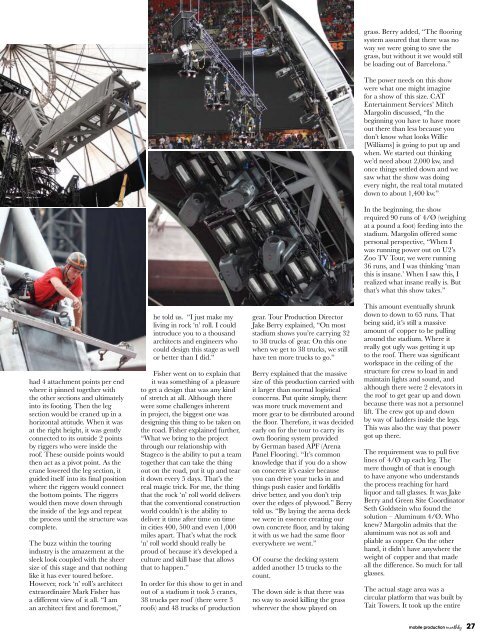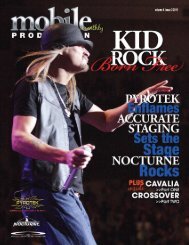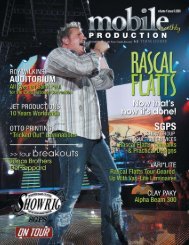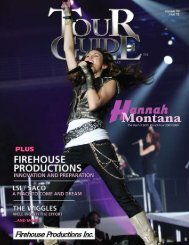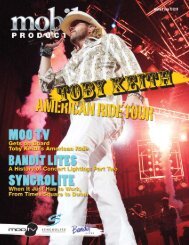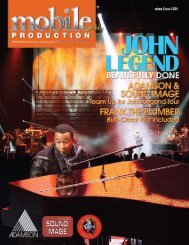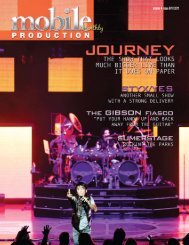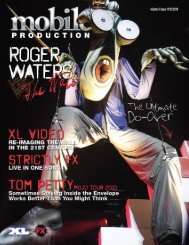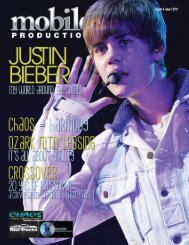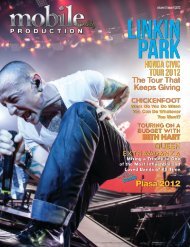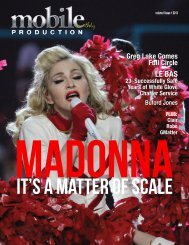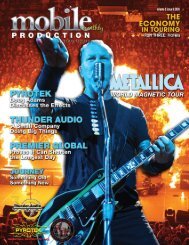volume 2 issue 12 2009 - Mobile Production Pro
volume 2 issue 12 2009 - Mobile Production Pro
volume 2 issue 12 2009 - Mobile Production Pro
Create successful ePaper yourself
Turn your PDF publications into a flip-book with our unique Google optimized e-Paper software.
grass. Berry added, “The flooringsystem assured that there was noway we were going to save thegrass, but without it we would stillbe loading out of Barcelona.”The power needs on this showwere what one might imaginefor a show of this size. CATEntertainment Services’ MitchMargolin discussed, “In thebeginning you have to have moreout there than less because youdon’t know what looks Willie[Williams] is going to put up andwhen. We started out thinkingwe’d need about 2,000 kw, andonce things settled down and wesaw what the show was doingevery night, the real total mutateddown to about 1,400 kw.”In the beginning, the showrequired 90 runs of 4/Ø (weighingat a pound a foot) feeding into thestadium. Margolin offered somepersonal perspective, “When Iwas running power out on U2’sZoo TV Tour, we were running36 runs, and I was thinking ‘manthis is insane.’ When I saw this, Irealized what insane really is. Butthat’s what this show takes.”had 4 attachment points per endwhere it pinned together withthe other sections and ultimatelyinto its footing. Then the legsection would be craned up in ahorizontal attitude. When it wasat the right height, it was gentlyconnected to its outside 2 pointsby riggers who were inside theroof. These outside points wouldthen act as a pivot point. As thecrane lowered the leg section, itguided itself into its final positionwhere the riggers would connectthe bottom points. The riggerswould then move down throughthe inside of the legs and repeatthe process until the structure wascomplete.The buzz within the touringindustry is the amazement at thesleek look coupled with the sheersize of this stage and that nothinglike it has ever toured before.However, rock ‘n’ roll’s architectextraordinaire Mark Fisher hasa different view of it all. “I aman architect first and foremost,”he told us. “I just make myliving in rock ‘n’ roll. I couldintroduce you to a thousandarchitects and engineers whocould design this stage as wellor better than I did.”Fisher went on to explain thatit was something of a pleasureto get a design that was any kindof stretch at all. Although therewere some challenges inherentin project, the biggest one wasdesigning this thing to be taken onthe road. Fisher explained further,“What we bring to the projectthrough our relationship withStageco is the ability to put a teamtogether that can take the thingout on the road, put it up and tearit down every 5 days. That’s thereal magic trick. For me, the thingthat the rock ‘n’ roll world deliversthat the conventional constructionworld couldn’t is the ability todeliver it time after time on timein cities 400, 500 and even 1,000miles apart. That’s what the rock‘n’ roll world should really beproud of because it’s developed aculture and skill base that allowsthat to happen.”In order for this show to get in andout of a stadium it took 5 cranes,38 trucks per roof (there were 3roofs) and 48 trucks of productiongear. Tour <strong><strong>Pro</strong>duction</strong> DirectorJake Berry explained, “On moststadium shows you’re carrying 32to 38 trucks of gear. On this onewhen we get to 38 trucks, we stillhave ten more trucks to go.”Berry explained that the massivesize of this production carried withit larger than normal logisticalconcerns. Put quite simply, therewas more truck movement andmore gear to be distributed aroundthe floor. Therefore, it was decidedearly on for the tour to carry itsown flooring system providedby German based APF (ArenaPanel Flooring). “It’s commonknowledge that if you do a showon concrete it’s easier becauseyou can drive your tucks in andthings push easier and forkliftsdrive better, and you don’t tripover the edges of plywood.” Berrytold us. “By laying the arena deckwe were in essence creating ourown concrete floor, and by takingit with us we had the same flooreverywhere we went.”Of course the decking systemadded another 15 trucks to thecount.The down side is that there wasno way to avoid killing the grasswherever the show played onThis amount eventually shrunkdown to down to 65 runs. Thatbeing said, it’s still a massiveamount of copper to be pullingaround the stadium. Where itreally got ugly was getting it upto the roof. There was significantworkspace in the ceiling of thestructure for crew to load in andmaintain lights and sound, andalthough there were 2 elevators inthe roof to get gear up and downbecause there was not a personnellift. The crew got up and downby way of ladders inside the legs.This was also the way that powergot up there.The requirement was to pull fivelines of 4/Ø up each leg. Themere thought of that is enoughto have anyone who understandsthe process reaching for hardliquor and tall glasses. It was JakeBerry and Green Site CoordinatorSeth Goldstein who found thesolution – Aluminum 4/Ø. Whoknew? Margolin admits that thealuminum was not as soft andpliable as copper. On the otherhand, it didn’t have anywhere theweight of copper and that madeall the difference. So much for tallglasses.The actual stage area was acircular platform that was built byTait Towers. It took up the entiremobile production monthly 27


